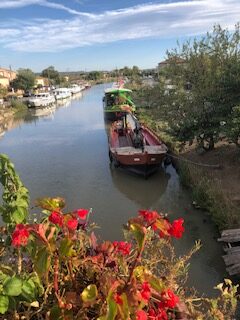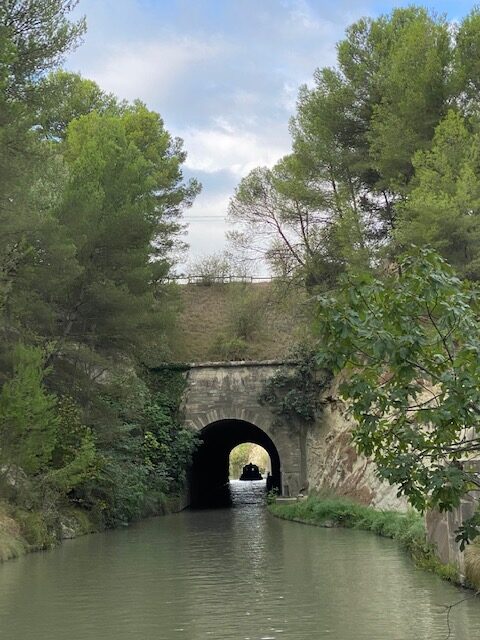
By Robert Waite
Homes, France – Nothing better illustrates the personality gulf that separated Benjamin Franklin from Thomas Jefferson than how they spent their time in France representing a fledging United States.
Franklin expended much effort navigating the city’s drawing rooms, entertaining comely women of status with his banter and wit.
Jefferson, on the other hand, ventured far afield. Unlike Franklin, his primary focus was not the fairer sex (or at least not the Parisian fairer sex – perhaps because he was accompanied to France by Sally Hemings), but rather civil engineering.
And the French engineering feat he most admired was the Canal of Languedoc, today better known as the Canal Midi.
Constructed in the 17th Century, the canal transverses France north of the Pyrenees and unites the Mediterranean with the Atlantic.
So transfixed was Jefferson by this marvel that in May of 1787 he spent
nine days on horseback examining its details and eight on the canal itself, enjoying the views.
“Of all of the methods of travelling I have ever tried this is the pleasantest,” he enthused in a letter to his friend William Short. In a letter written on the same day to his daughter Patsy, he noted, “cloudless skies above; limpid water below; and a row of nightingales in full chorus.”
While I cannot promise you nightingales in full chorus (or even cloudless skies), I can vouch for the pleasures of plying the Canal Midi’s waters, having recently done so myself.

Threading a Needle
My only caveat is that you are sometimes trying to thread a nautical needle – and that takes a bit of skill, as well as a competent crew. And if you’ve seen those ads for Viking Cruises on the Danube or the Rhine – the ones with passengers lounging in luxury as crew members cater to their every need – put that image out of your mind.
The canal boats are very nice, but you do the catering. That aside, cruising on this UNESCO World Heritage Site, completed in 1681, is a rewarding experience.
The canal’s role in conveying goods, as it did in Jefferson’s time, ceased by the end of World War II. Today, it carries would-be captains cruising in specially fitted-out craft. Fully 10,000 boats make their way up and down its 149-mile length each year. Our boat is 44 feet long and, in theory, sleeps six, although this would require all six to be contortionists or experts at spooning.
We are, however, only three — my spouse (Karen), her sister (Jodi), and me. A cousin, Shaun, had dropped out due to some sort of domestic calamity (or, more likely, a premonition).
Having plied the waters of Ipswich Bay in Massachusetts in my youth on my dad’s 22-foot craft, including successfully navigating the Essex, Parker, and Ipswich rivers, I reasoned that captaining a boat on a canal would be a breeze. If nothing else, it would be difficult to get lost.

Bumpy Ride Ahead?
My first clue that I might be mistaken in this assumption came when I examined our boat more closely. It was festooned all around with thick rubber strips. Hung at intervals along the hull were bulbous black bumpers. This had the effect of making the boat look more like one of those bumper-car rides you’d find at an amusement park.
The company renting the craft, Le Boat, had sent out a video in advance, one I actually watched. They also provided a kind of online manual which, identifying as a male, I completely ignored.
We were taken out for a test run by a whippet-thin woman named Mimi, who repeatedly told me that I would do just fine — even as I began to fishtail in the strong breeze. “Yes, it is windy like this 300 days a year,” she cheerfully allowed, “but you’ll get used to it.”
I did not get used to it. I also discovered that a 44-foot boat handles quite differently than one that clocks in at a mere 22 feet. And that side-thrusters — jets of water that move you laterally left or right — take a bit of practice to master.

Steep Learning Curve
The reason for all of the bumpers, side-thrusters, and obligatory manual-reading soon became apparent as we headed out.
The canal is straddled by numerous bridges, many dating from the 17th century. Built of stone and with arches so low that standing up on the bridge would get you KO’d, they are barely wide enough to accommodate one boat at a time. Hence the threading a needle analogy.
A combination of a wind gust, too much speed, and frantic side-jet toggling caused the boat to bounce side-to-side off the walls of the first bridge. It was like being inside a pinball machine.
While we did not go down with the ship, we did lose one of our bulbous bumpers. All that was left, in mute testimony, was a swaying, severed, blue nylon rope.
And then there were the locks. Lots and lots of locks. While we did not nearly do them all — there are 74 that drop you 620 feet as you travel eastwards — each must be carefully choreographed, as typically three boats share space in the lock as you are moved up or down.
Again, as with the bridges, there was a steep learning curve. Fortunately, unlike their captain, my crew of two were quick to figure out how to secure the ropes and where to step when. All of this seemed to entertain the lock-keepers as well as other boat crews.

Settling in
After the initial teething issues, things settled down. We moored on the banks of lovely villages some nights, enjoying the local cuisine and visiting a chateau, church, or, in one instance, an enormous canal-side bookstore boasting 50,000 titles. At other times, we pulled off (to quote Mimi) “in full nature,” mooring under southern French skies.
I would recommend the trip. Once you get past your first moments of sheer terror, the experience is relaxing and good for the soul (if not the waistline). But for those of you who pride yourself on your prowess navigating a local lake or the coastal areas along the Atlantic, Pacific or Gulf coastlines – read the manual!
Jefferson, by the way, returned to America as a fervent canal advocate. But he drew the line at the construction of the Erie Canal, linking Buffalo and the Great Lakes to New York City and the Atlantic, a distance of 350 miles.
“It is a little short of madness to be thought of in this day” he is reported to have responded when his support was sought by Joshua Forman, an Erie Canal proponent. History proved him wrong.

IF YOU GO
We used a company called Le Boat to obtain a boat rental, in our case for one week. There are a wide variety of boats to choose from as well as itineraries. Some craft have air conditioning, which might be a wise choice in the summer months. We went in late September, so temperatures were pleasant.
One sad footnote is that most of the beautiful plane trees (Plantanes en francais) that lined the canal in Jefferson’s day have recently succumbed to disease. The good news is that France has been diligent about replacing them with a different, but equally shady, species.
We chose to begin and end in the town of Homes; you can also select an itinerary where you do not have to return to your starting point. I would suggest staying overnight in town the night before you depart. Among other things, you can find a market where you can obtain goods to stock your boat.
There are many good restaurants in towns along the canal route that cater to boaters. Our preference was to enjoy breakfast and lunch on board and have dinner each evening ashore.
In terms of getting to the canal, we flew into Barcelona and took a train to Narbonne, France. From there we took a taxi to Homes. An alternative (especially if you are embarking from a port further to the west) is to fly into Toulouse, France. You do not need a license to operate the boat.
Top photo credit: Karen Shigeishi-Waite. All other photos by Robert Waite.
Author Bio: Robert Waite is the author of Ipswich on My Mind and Ipswich Out of My Mind, a compilation of humorous reminiscences about growing up in Ipswich, Massachusetts.












2 Responses to The Perils and Pleasures of Navigating a French Canal